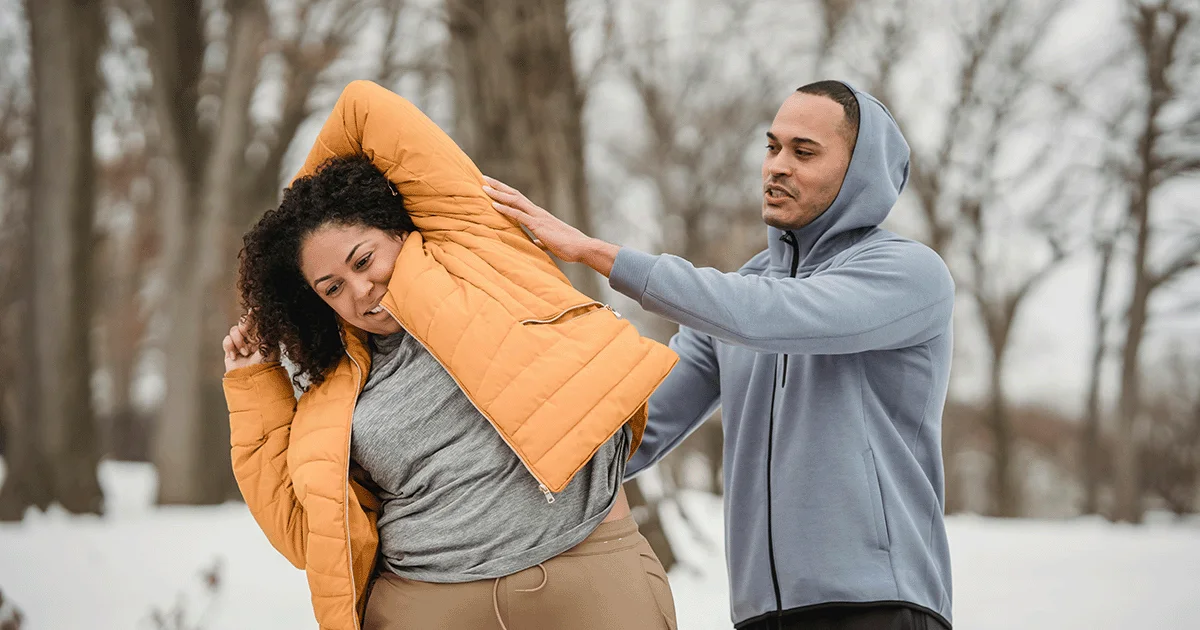Key takeaways
Nausea is a common side effect of semaglutide, affecting around 20% of people taking the drug.
You can relieve nausea from Ozempic by eating smaller meals, more often, and avoiding fried, greasy, and sugary foods.
Here's what we'll cover
Key takeaways
Nausea is a common side effect of semaglutide, affecting around 20% of people taking the drug.
You can relieve nausea from Ozempic by eating smaller meals, more often, and avoiding fried, greasy, and sugary foods.
If you’ve been taking Ozempic for weight loss or type 2 diabetes, it’s likely you’ve encountered its most famous — or shall we say infamous — side effect: nausea. Nausea is the most common side effect of Ozempic, affecting around 1 in 5 people taking the medication.
The good news is there are ways to relieve nausea while taking Ozempic. Read on as we explain how Ozempic works, why it can cause nausea, and what you can do to reduce the side effects of Ozempic.
Ozempic Important Safety Information: Read more about serious warnings and safety info.
What is Ozempic?
Ozempic (semaglutide) is an injectable prescription medication that helps control blood sugar levels and reduce cardiovascular risk in people with type 2 diabetes. While the drug is only FDA-approved to treat type 2 diabetes, its active ingredient — semaglutide — is highly effective at helping people lose weight, when used in combination with diet and exercise. This is why many doctors prescribe it off-label for weight loss, if they think it is appropriate. On average, people taking the maximum dosage of semaglutide (2.4mg) lose up to 15% of their body weight within a year and a half of starting treatment.
Novo Nordisk, the makers of Ozempic, market the same active ingredient in Ozempic (semaglutide) under the brand name Wegovy for weight loss. This medication is available in higher dosages and is FDA-approved for weight loss in people with obesity or overweight. Providers may prescribe Ozempic or Wegovy for weight loss depending on their patient's health conditions.
Why does Ozempic cause nausea?
Researchers do not know exactly why Ozempic causes nausea, but it probably has something to do with how the drug works — specifically, how it activates GLP-1 receptors and slows gastric emptying. Gastric emptying is when food leaves your stomach and enters the small intestine.
Ozempic is a glucagon-like peptide-1 (GLP-1) receptor agonist. It mimics a gut hormone produced naturally in your body, called GLP-1. Among other things, GLP-1 is responsible for telling your brain when you’re full. It also encourages your pancreas to release insulin after you eat, slows gastric emptying, and may even play a role in your brain’s reward system around food. Together, these effects help with blood sugar control and appetite reduction — both of which help people taking Ozempic to manage their type 2 diabetes, lose weight, or both.
Given GLP-1’s role in your digestion, it makes sense that GLP-1 agonists like Ozempic cause gastrointestinal side effects like nausea, vomiting, and diarrhea. And because GLP-1 makes you feel full — both by telling your brain you’re full and by keeping food in your stomach longer — you may experience nausea when you try to eat on Ozempic.
How to relieve nausea on Ozempic
Nausea is a common side effect of semaglutide, affecting around 20% of people taking the maximum doses of Ozempic (1 mg), and nearly half (44%) of people taking the higher maximum doses of Wegovy (2.4 mg). The good news is that the nausea is mild to moderate for most people, and tends to go away with time as your body gets used to the medication. Until then, here are five ways to relieve nausea on Ozempic.
1. Watch what you eat
A change in diet is recommended to people taking Ozempic, whether they are taking it for type 2 diabetes, weight loss, or both. Usually, your healthcare provider will recommend eating less overall to help manage blood sugar levels and help with weight loss.
For nausea, however, you will want to avoid eating fried, greasy, and sugary foods. These contribute to nausea, and don’t help with glycemic (blood sugar) control or weight loss. In particular, try to eliminate the following foods from your diet:
White bread
Doughnuts and other pastries
Burgers
Fried foods
Chips
Sausage
Canned or processed foods
Other salty or spicy foods
Instead, eat low-fat, bland foods and foods that contain a lot of water, such as:
Crackers
Toast
English muffins
Baked chicken
Baked fish
Potatoes
Noodles
Rice
Soup
Chicken broth
Carrots
Fruit (without the skin)
Gelatin (jello)
Popsicles
Yogurt
2. Change how you eat
In addition to adjusting what you eat, changing the way you eat can also reduce nausea while taking Ozempic.
Start by eating smaller portions, more often. Also, try to eat slowly and savor your meal. Once you feel full, stop eating.
When you’re done eating, avoid lying down. Along the same lines, don’t eat right before bed.
3. Drink ice-cold, clear drinks
As for what you drink, opt for something ice-cold, and clear.
You want to ensure you drink plenty of fluids, but drink in small sips to avoid feeling too full. Try to drink straight from the glass and avoid using a straw.
What should you drink on Ozempic? Water is always a good option. You can also sip on fresh fruit juice, sports drinks, and other healthy drinks. Just check the sugar content first to avoid any blood sugar spikes. Ginger-based beverages like ginger ale may also relieve feelings of nausea.
If you have extreme nausea and have to vomit (9% of people taking the maximum dose of Ozempic report vomiting), make sure you drink plenty of fluids to rehydrate. As with nausea, vomiting is more common when you first start taking Ozempic, and when you ramp up your dose.
4. Avoid other nausea triggers
If there’s anything you know that triggers your nausea, avoid it. For some people, that’s motion sickness. For others, it can be strong smells or even stress.
After you eat, try to get some fresh air. You want to avoid being too active after a meal, but light exercise can help settle your stomach. Try a short walk around your neighborhood, or play fetch with your dog outside.
5. Talk to your healthcare provider
Talk to your healthcare provider if your nausea isn’t going away or causing you significant distress. They may be able to adjust your dosage of Ozempic or offer other suggestions for relieving your nausea, such as anti-nausea medications.
For some people, the nausea they experience on Ozempic is too much. If you feel like that might be you, talk to your healthcare provider about alternatives to Ozempic. Several other GLP-1 medications, including Mounjaro, Saxenda, and others, can lead to weight loss. While you can expect some level of gastrointestinal distress with these medications, research shows that nausea tends to be most frequent with semaglutide (the active ingredient in Ozempic) and tirzapetide (the active ingredient in Mounjaro).
Foods to reduce nausea
Beyond changing your diet and eating habits, a handful of foods have been shown to relieve nausea, including crackers, apples, mint, and ginger.
Ginger
While more research is still needed, a growing number of studies have found ginger relieves nausea and vomiting in various situations, from morning sickness during pregnancy to chemotherapy-induced nausea.
You can find ginger in ginger supplements, ginger powder, ginger ale and ginger-based drinks, and ginger root.
Apples
Apples may also help relieve some of the Ozempic nausea, although you might want to remove the skin first, if you’re concerned about having too much fiber. In a study of women with hyperemesis gravidarum (severe nausea and vomiting during pregnancy), apples were associated with the least nausea.
Mint
Mint has long been used to combat indigestion after dinner, but it may also reduce nausea from Ozempic. Try sipping a cup of mint tea or mixing some mint leaves into your salad.
Peppermint essential oils have been studied extensively among people who experience nausea, including pregnant women, people with cancer undergoing chemotherapy, post-op surgical patients, and people in the hospital. In all of these studies, it was found to be effective in relieving their nausea.
Crackers
Crackers, including graham crackers and saltine or soda crackers, are a bland food recommended to people experiencing nausea on Ozempic. In people with gastroparesis (a condition characterized by delayed gastric emptying), saltine and graham crackers improved symptoms, as did jello.
If you’re experiencing nausea on Ozempic, talk to your healthcare provider. They can offer additional suggestions for nausea relief based on your personal health situation.
DISCLAIMER
If you have any medical questions or concerns, please talk to your healthcare provider. The articles on Health Guide are underpinned by peer-reviewed research and information drawn from medical societies and governmental agencies. However, they are not a substitute for professional medical advice, diagnosis, or treatment.
References
Amzajerdi, A., Keshavarz, M., Montazeri, A., et al. (2019). Effect of mint aroma on nausea, vomiting and anxiety in pregnant women. Journal of Family Medicine and Primary Care, 8(8), 2597–2601. doi:10.4103/jfmpc.jfmpc_480_19. Retrieved from https://www.ncbi.nlm.nih.gov/pmc/articles/PMC6753788/
Anh, N. H., Kim, S. J., Long, N. P., et al. (2020). Ginger on Human Health: A Comprehensive Systematic Review of 109 Randomized Controlled Trials. Nutrients, 12(1), 157. doi:10.3390/nu12010157. Retrieved from https://www.ncbi.nlm.nih.gov/pmc/articles/PMC7019938/
Collins, L. & Costello, R. A. (2023). Glucagon-like Peptide-1 Receptor Agonists. StatPearls. Retrieved from https://www.ncbi.nlm.nih.gov/books/NBK551568/
Efe Ertürk, N. & Taşcı, S. (2021). The Effects of Peppermint Oil on Nausea, Vomiting and Retching in Cancer Patients Undergoing Chemotherapy: An Open Label Quasi-Randomized Controlled Pilot Study. Complementary Therapies in Medicine, 56, 102587. doi:10.1016/j.ctim.2020.102587. Retrieved from https://pubmed.ncbi.nlm.nih.gov/33197662/
Giacosa, A., Morazzoni, P., Bombardelli, E., et al. (2015). Can nausea and vomiting be treated with ginger extract?. European Review for Medical and Pharmacological Sciences, 19(7), 1291–1296. Retrieved from https://pubmed.ncbi.nlm.nih.gov/25912592/
Gorgojo-Martínez, J. J., Mezquita-Raya, P., Carretero-Gómez, J., et al. (2022). Clinical Recommendations to Manage Gastrointestinal Adverse Events in Patients Treated with Glp-1 Receptor Agonists: A Multidisciplinary Expert Consensus. Journal of Clinical Medicine, 12(1), 145. doi:10.3390/jcm12010145. Retrieved from https://www.ncbi.nlm.nih.gov/pmc/articles/PMC9821052/
Maghami, M., Afazel, M. R., Azizi-Fini, I., et al. (2020). The effect of aromatherapy with peppermint essential oil on nausea and vomiting after cardiac surgery: A randomized clinical trial. Complementary Therapies in Clinical Practice, 40, 101199. doi:10.1016/j.ctcp.2020.101199. Retrieved from https://pubmed.ncbi.nlm.nih.gov/32891278/
MedlinePlus. (2022). When you have nausea and vomiting. Retrieved from https://medlineplus.gov/ency/patientinstructions/000122.htm
Mohr, C., Jensen, C., Padden, N., et al. (2021). Peppermint Essential Oil for Nausea and Vomiting in Hospitalized Patients: Incorporating Holistic Patient Decision Making Into the Research Design. Journal of Holistic Nursing, 39(2), 126–134. doi:10.1177/0898010120961579. Retrieved from https://pubmed.ncbi.nlm.nih.gov/32985338/
Müller, T. D., Finan, B., Bloom, S. R., et al. (2019). Glucagon-like peptide 1 (GLP-1). Molecular Metabolism, 30, 72–130. doi:10.1016/j.molmet.2019.09.010. Retrieved from https://www.ncbi.nlm.nih.gov/pmc/articles/PMC6812410/
Novo Nordisk. (2022). Ozempic Side Effects. Retrieved from https://www.ozempic.com/how-to-take/side-effects.html
Shu, Y., He, X., Wu, P., et al. (2022). Gastrointestinal adverse events associated with semaglutide: A pharmacovigilance study based on FDA adverse event reporting system. Frontiers in Public Health, 10, 996179. doi:10.3389/fpubh.2022.996179. Retrieved from https://www.ncbi.nlm.nih.gov/pmc/articles/PMC9631444/
Spirling, L. I. & Daniels, I. R. (2001). Botanical perspectives on health peppermint: more than just an after-dinner mint. The Journal of the Royal Society for the Promotion of Health, 121(1), 62–63. doi:10.1177/146642400112100113. Retrieved from https://pubmed.ncbi.nlm.nih.gov/11329700/
Tan, G. N., Tan, P. C., Hong, J. G. S., et al. (2021). Rating of four different foods in women with hyperemesis gravidarum: a randomised controlled trial. BMJ Open, 11(5), e046528. doi:10.1136/bmjopen-2020-046528. Retrieved from https://www.ncbi.nlm.nih.gov/pmc/articles/PMC8126296/
Trujillo, J. M., Nuffer, W., & Smith, B. A. (2021). GLP-1 receptor agonists: an updated review of head-to-head clinical studies. Therapeutic Advances in Endocrinology and Metabolism, 12, 2042018821997320. doi:10.1177/2042018821997320. Retrieved from https://www.ncbi.nlm.nih.gov/pmc/articles/PMC7953228/
U.S. Food and Drug Administration (FDA-a). (2022). Highlights of Prescribing Information: OZEMPIC (semaglutide) injection, for subcutaneous use. Retrieved from https://www.accessdata.fda.gov/drugsatfda_docs/label/2022/209637Orig1s009lbl.pdf
U.S. Food and Drug Administration (FDA-b). (2022). Highlights of Prescribing Information: WEGOVY (semaglutide) injection, for subcutaneous use. Retrieved from https://www.accessdata.fda.gov/drugsatfda_docs/label/2022/215256s005lbl.pdf
Wilding, J. P. H., Batterham, R. L., Calanna, S., et al. (2021). Once-Weekly Semaglutide in Adults with Overweight or Obesity. The New England Journal of Medicine, 384(11), 989–1002. doi:10.1056/NEJMoa2032183. Retrieved from https://www.nejm.org/doi/full/10.1056/NEJMoa2032183
Wytiaz, V., Homko, C., Duffy, F., et al. (2015). Foods provoking and alleviating symptoms in gastroparesis: patient experiences. Digestive Diseases and Sciences, 60(4), 1052–1058. doi:10.1007/s10620-015-3651-7. Retrieved from https://pubmed.ncbi.nlm.nih.gov/25840923/











